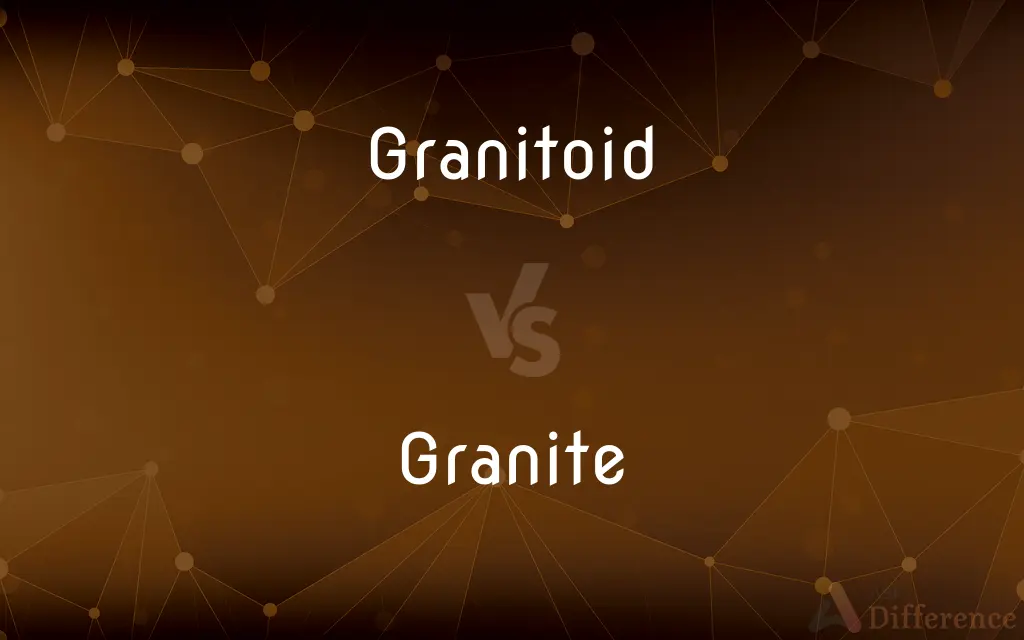Granitoid vs. Granite — What's the Difference?
Edited by Tayyaba Rehman — By Maham Liaqat — Updated on April 24, 2024
Granitoid refers to a broad category of coarse-grained igneous rocks similar to granite, while granite is a specific type of granitoid characterized by its quartz and feldspar content.

Difference Between Granitoid and Granite
Table of Contents
ADVERTISEMENT
Key Differences
Granite is a well-known type of granitoid, specifically known for its coarse-grained structure and composition primarily of quartz, feldspar, and mica, whereas granitoid is a broader term encompassing a range of similar igneous rocks.
Granitoids include various rock types such as granite, granodiorite, tonalite, and others, which share textural similarities but differ in chemical and mineral compositions, whereas granite has a specific mineralogical composition that fits within this broader category.
Granite is often used in construction and monuments due to its durability and aesthetic appeal, specifically chosen for its uniformity and beauty, whereas granitoids might be selected based on different properties suitable for various engineering and decorative purposes.
In geological studies, granite is studied for its clear, defined characteristics which make it a significant element of the continental crust, whereas granitoids are examined for their diversity and what they can reveal about Earth’s geologic history.
The term "granite" often comes up in commercial and residential settings when discussing countertops or flooring, reflecting its specific use and recognition, whereas "granitoid" is more likely to be used in academic or geological discussions about rock classifications.
ADVERTISEMENT
Comparison Chart
Definition
A category of coarse-grained igneous rocks that resemble granite.
A type of granitoid, coarse-grained igneous rock composed mainly of quartz, feldspar, and mica.
Composition
Varies, but generally includes quartz and feldspar among other minerals.
Quartz, feldspar, and mica.
Usage
Used broadly in geological classifications; less specific in commercial use.
Widely used in construction, monuments, and as decorative stone.
Examples
Includes granite, granodiorite, tonalite, etc.
Traditional granite used in kitchen countertops.
Geological Significance
Important for studying the diversity and formation processes of the Earth’s crust.
Integral to understanding continental crust composition.
Compare with Definitions
Granitoid
Encompasses a variety of coarse-grained igneous rocks including granite.
The geologist explained that the rock sample was a type of granitoid, not pure granite.
Granite
Often has a granular and phaneritic texture, making it distinctive.
The granite rock was easily identifiable by its grainy texture and pink hue.
Granitoid
Can vary widely in exact composition and color.
The granitoid displayed at the museum varied from light gray to dark pink.
Granite
Commonly used in building and sculpting for its durability and aesthetics.
The majestic building was constructed with large blocks of granite.
Granitoid
Used in geological classifications to group similar igneous rocks.
This range of hills is composed of several types of granitoids.
Granite
Predominantly found in continental crust, forming large plutons.
The mountain range consists mostly of exposed granite formations.
Granitoid
Important in studies of Earth’s crust due to their commonality and diversity.
The study focused on the different granitoid compositions found across the continent.
Granite
A hard, coarse-grained rock consisting mostly of quartz, feldspar, and mica.
The new kitchen features countertops made of polished granite.
Granitoid
Less likely to be specified in commercial settings compared to granite.
While granite is popular for countertops, other granitoids are less frequently used.
Granite
Preferred for decorative and functional purposes due to its beauty and strength.
The artist chose granite for the sculpture to ensure it would withstand the elements.
Granitoid
A granitoid is a generic term for a diverse category of coarse-grained igneous rocks that consist predominantly of quartz, plagioclase, and alkali feldspar. Granitoids range from plagioclase-rich tonalites to alkali-rich lsyenites and from quartz-poor monzonites to quartz-rich quartzolites.
Granite
Granite () is a coarse-grained igneous rock composed mostly of quartz, alkali feldspar, and plagioclase. It forms from magma with a high content of silica and alkali metal oxides that slowly cools and solidifies underground.
Granitoid
A common, coarse-grained, light-colored, hard igneous rock consisting chiefly of quartz, orthoclase or microcline, and mica, used in monuments and for building.
Granite
A common, coarse-grained, light-colored, hard igneous rock consisting chiefly of quartz, orthoclase or microcline, and mica, used in monuments and for building.
Granitoid
Unyielding endurance; steadfastness
A will of granite.
Granite
Unyielding endurance; steadfastness
A will of granite.
Granitoid
(geology) Resembling granite.
Granitoid gneiss
Granite
(rock) A group of igneous and plutonic rocks composed primarily of feldspar and quartz. Usually contains one or more dark minerals, which may be mica, pyroxene, or amphibole. Granite is quarried for building stone, road gravel, decorative stone, and tombstones. Common colors are gray, white, pink, and yellow-brown.
Granitoid
(geology) Any mineral that resembles granite.
Granite
Toughness; the quality of having a thick skin or being rough.
Granitoid
Resembling granite in granular appearance; as, granitoid gneiss; a granitoid pavement.
Granite
A crystalline, granular rock, consisting of quartz, feldspar, and mica, and usually of a whitish, grayish, or flesh-red color. It differs from gneiss in not having the mica in planes, and therefore in being destitute of a schistose structure.
Granite
Plutonic igneous rock having visibly crystalline texture; generally composed of feldspar and mica and quartz
Granite
Something having the quality of granite (unyielding firmness);
A man of granite
Common Curiosities
Why is granite more commonly used in household settings than other granitoids?
Due to its durability, aesthetic appeal, and uniformity, granite is more frequently chosen for household applications like countertops and flooring.
What is the best way to maintain granite surfaces?
Maintaining granite involves regular cleaning with mild detergent and periodic sealing to protect its surface.
How are granitoids important to geologists?
Granitoids help geologists understand the processes that form the Earth’s crust and the composition of different geological structures.
Is there a price difference between granite and other granitoids?
Price can vary depending on availability, demand, and specific characteristics of the rock, with granite often being on the higher end due to its popularity.
Can granitoid rocks be used for the same purposes as granite?
Yes, other granitoids can be used similarly to granite but may not always offer the same visual appeal or uniform characteristics.
Are all granitoids suitable for kitchen countertops?
Not all granitoids have the necessary properties, like porosity and hardness, which make granite ideal for kitchen use.
What distinguishes granite from other granitoids?
Granite is specifically composed of quartz, feldspar, and mica, which sets it apart from other granitoids that may have different compositions.
What are the common uses of granitoids in construction?
Granitoids are used for building facades, monuments, and sometimes in paving, depending on their properties.
Is there a geological setting where granite is more prevalent than other granitoids?
Granite is often more prevalent in continental crust settings, particularly in areas with a history of tectonic activity involving magma.
How are granite and granitoids formed?
Both are formed from the cooling and solidification of magma beneath the Earth’s surface, though the exact processes and conditions may vary.
What are the aesthetic differences between granite and other granitoids?
Granite typically has a more uniform and often colorful appearance, whereas other granitoids might vary more in texture and color.
How do the physical properties of granite compare to those of other granitoids?
While all granitoids are generally hard and durable, granite often has particularly strong and less porous characteristics, making it highly suitable for certain applications.
What are the environmental impacts of quarrying granite and other granitoids?
Quarrying can have significant environmental impacts, including habitat destruction and pollution, which need to be managed responsibly.
Why might a builder choose a non-granite granitoid over granite?
Choices may be driven by cost considerations, availability, specific physical properties needed for the project, or simply aesthetic preference.
Can granite and other granitoids be recycled?
Yes, they can be repurposed for various uses such as aggregate in construction or as decorative pieces in landscaping.
Share Your Discovery

Previous Comparison
Morphology vs. Topology
Next Comparison
Surname vs. TitleAuthor Spotlight
Written by
Maham LiaqatEdited by
Tayyaba RehmanTayyaba Rehman is a distinguished writer, currently serving as a primary contributor to askdifference.com. As a researcher in semantics and etymology, Tayyaba's passion for the complexity of languages and their distinctions has found a perfect home on the platform. Tayyaba delves into the intricacies of language, distinguishing between commonly confused words and phrases, thereby providing clarity for readers worldwide.














































